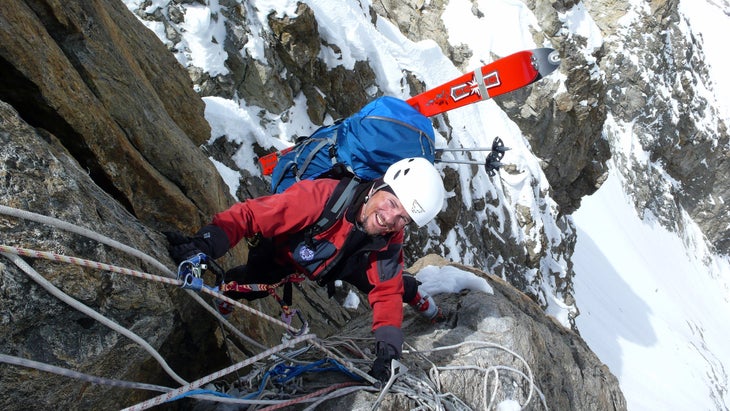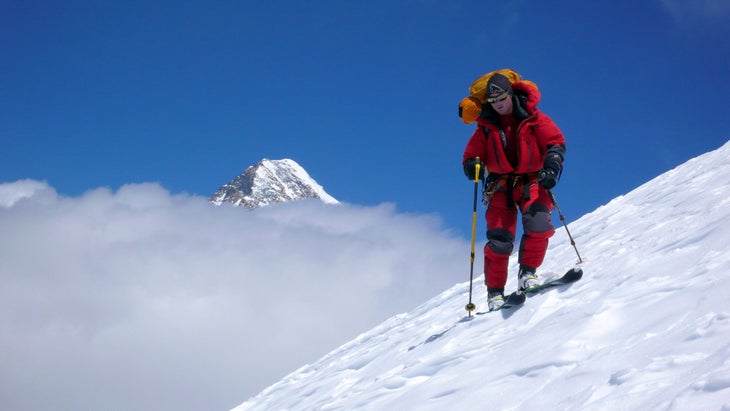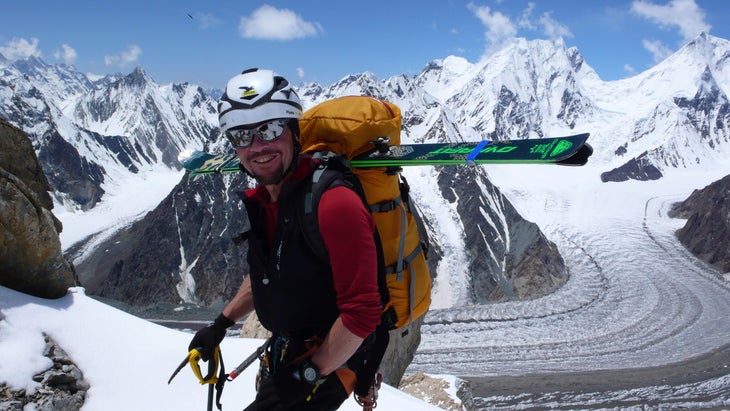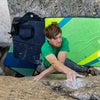A Climber We Lost: Luis Stitzinger
Each January we post a farewell tribute to those members of our community lost in the year just past. Some of the people you may have heard of, some not. All are part of our community and contributed to climbing.
Heading out the door? Read this article on the new Outside+ app available now on iOS devices for members! Download the app.
You can read the full tribute to Climbers We Lost in 2023 here.
Luis Stitzinger, 56, May 25
Luis Stitzinger, one of the greatest high altitude ski mountaineers of the modern era, “was born with skis on his feet,” says his wife and longtime climbing partner, Alix von Melle, who has herself climbed seven 8,000-meter peaks. Luis grew up in Füssen, a small town in Bavaria’s Ammergau Alps where his father, Volkmar Stitzinger, was a leading mountain guide and one of the pioneers of the local German Alpine Club—the same program that introduced Luis to climbing.
“Luis spent every free minute in the mountains,” Alix told Climbing, “either professionally as a mountain guide or privately with me.”
Luis and Alix met while climbing in Munich during their student years, and by the time they married in 2011, they were already one of mountaineering’s strongest couples. “We spent 25 years of our lives together,” she recalls. “We did everything together. We trained together, we went on expeditions together, we gave lectures together, we worked together. But we also gave each other room to maneuver for our own projects. Our partnership was characterized by great trust and humor. We loved and celebrated life together.”

Over the course of his 30-year career, Luis summited 10 8,000-meter peaks (some multiple times), skied down seven, and climbed six alongside his wife. He only used supplemental oxygen when guiding clients on Mt. Everest.
In 2006 he made the first ski descent of Gasherbrum II (8034 meters) along with Sebastian Haag (1978 – 2014) and Benedikt Böhm. In 2008 he made the first descent of the Diamer Face of Nanga Parbat (which he summited multiple times that season), clipping into his skis at 7,850 meters, 300 feet below the mountain’s top. In 2014, shortly after summiting Broad Peak (8,051 meters) with Alix and skiing off it, he climbed just past the 8,000-meter mark on K2 before being turned around by bad weather; he then skied from Camp 4 to the mountain’s base via the Kukuczka-Piotrowski Route (also sometimes called the Polish route)—the first ski descent of the line and the longest ski descent on K2 until Andrzej Bargiel linked the whole mountain in 2018.

Lukas Furtenbach, the founder and owner of Furtenbach Adventures, one of the world’s premier high altitude guiding services, personally witnessed Luis’s 2008 descent of the Diamir flank on Nanga Parbat and immediately understood “that the maestro was at work on his masterpiece.”
Despite his accomplishments in the mountains (a more complete list of which can be found on his Wikipedia page), “Luis was anything but a daredevil or a gambler,” says his friend Wolfi Mayr. “Anyone who has ever traveled with him knows of his cautious and level-headed nature.”
Alix seconds this. “Luis went to the mountains for the mountain experience, not for possible records or career highlights. He always remained true to himself and lived his passion for the mountains without ever trying to market himself.”
Indeed, Luis spent a significant part of his career helping others acquire safe and successful experiences on the world’s highest mountains. He spent several seasons on Mt. Everest with Furtenbach Adventures, and in 2022, while working as a private guide, helped Graham Keene, age 68, become the oldest British man to summit the world’s highest mountain. “Luis was professional, strong, patient, calm, resuring, modest and most importantly a joy to be with,” Keen recalls.

In May 2023, however, Luis attempted what Mayr calls “his great ski mountaineering dream”: to make a solo ascent the world’s third highest mountain, Kangchenjunga (8586 meters), without bottled oxygen or sherpa support, and then ski from the summit region to Base Camp. True to form, Luis reached the summit at 5:00 p.m. on May 25 and turned around, having made the decision to cache his skis several hundred meters below. But at 7:00 p.m. he was still near the summit, and nothing more was heard from him after 9:30. There were no teams close enough to offer assistance, and bad weather kept helicopters grounded for the next two days, so it wasn’t until May 30 that a Sherpa team found his body at 8,400 meters. He was still wearing his crampons, having failed to descend all the way to his ski depot. An autopsy later revealed that he had come down with high altitude cerebral and pulmonary edema, and that he died in his sleep sometime in the night of May 25 or early morning of May 26.
There was a vast outpouring of love and grief following Luis’s death. As his friend and fellow guide Dave Watson wrote on Instagram, “When one of the world’s greatest extreme altitude ski mountaineers passes and all the articles mention his kindness and friendliness before any of his numerous accomplishments, you get an idea of just how special of a human he was. Positive vibes always, humility, compassion and kindness. Pure stoke, pure aloha, he was the best kind of person.”
In the wake of her husband’s passing, Alix says that the best way to honor him is to “continue living Luis’s and my passion for the mountains and our life, alone.”
—Steven Potter

